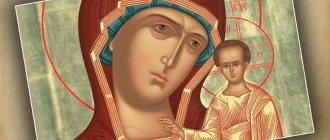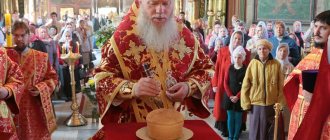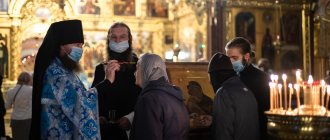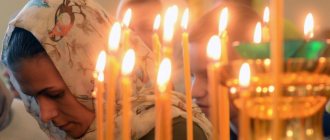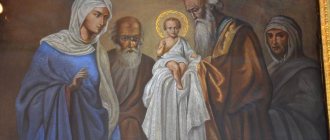In Orthodoxy, there are twelve most significant holidays - these are 12 especially important events of the church calendar, in addition to the main holiday - the great event of Easter.
This number includes both moving holidays and holidays with a fixed date. The most important holiday and celebration of celebrations is the Resurrection of Christ (Easter). We have prepared a complete list of these holidays. The dates of non-moving holidays are indicated according to the Gregorian calendar.
Orthodox calendar: what is it?
The Church lives according to the so-called Julian calendar: a yearly cycle in which there are the same number of days as in our “regular” calendar, and in general everything is exactly the same, with the only difference that the beginning of the year (and the Church beginning of the year) is September 1, and not in January.
Every day in the Church is a memory of some event or saint. For example, on January 7, the Nativity of Christ is remembered (or rather, celebrated). And thus, over the course of a year, the Church “lives” all the main events of its history, the earthly life of Christ, the Mother of God, the Apostles, and also remembers all its saints - not only the most revered (for example, Ambrose of Optina), but in general all of them. Each saint has his own day of remembrance, and every day of the year is a memory—a holiday—of one or another saint, and most often, not one, but several saints are remembered per day.
(For example, take March 13 - this is the day of remembrance of ten saints: St. John Cassian the Roman, St. Basil the Confessor, Hieromartyr Arseny Metropolitan of Rostov, Hieromartyr Nestor Bishop of Magiddia, Reverend Wives Marina and Kira, Hieromartyr Proterius Patriarch of Alexandria, St. John-named Barsanuphius Bp. . Damascus hermit of Nitria, venerable martyr Theoktirist, hegumen of Pelicitsky, blessed Nicholas Sallos of Christ for the sake of the holy fool of Pskov)
It turns out that if the secular calendar is divided into holidays and non-holidays (and there are very few holidays in it), then the Church calendar consists entirely of holidays, since every day one or another event is remembered and the memory of one or another saint is celebrated.
This is a reflection of the whole essence of Christian existence, when rejoicing in the Lord and His saints does not occur on certain days of the week or year, but constantly. Whether it was a joke or not, a proverb was even born among the people: “For the Orthodox, every day is a holiday.” Actually, that's exactly the case. Although, there are exceptions: some days of Lent, which require special concentration.
Icon “for every day of the year” - an image, if possible, of all the saints and the main Church Feasts
weeks in which there is no fast on Wednesday and Friday
January 7 - 18 - Christmastide
February 14 - 19 ‒ The Publican and the Pharisee
February 28 - March 6 ‒ Maslenitsa
April 25 - 30 ‒ Easter week
June 13 - 19 - Trinity Week
calendar schedule of Orthodox holidays
What holidays are there in Christianity?
Speaking in very general terms, Holidays in the Orthodox Church can be divided into the following “categories”:
- Easter
(Resurrection of Christ) is the main holiday. - The Twelfth Feasts
are 12 holidays that commemorate the main events in the life of the Blessed Virgin Mary and Jesus Christ. Some of them are reflected in the texts of the New Testament (the Gospel or the Acts of the Apostles), and some (the Nativity of the Mother of God, the Entry into the Temple of the Blessed Virgin Mary, the Exaltation of the Cross of the Lord) are taken from Church Tradition. Most of them have a specific date of celebration, but some depend on the date of Easter. We tell you more about each Twelfth holiday below. - Five Great Non-Twelfth Holidays
. Circumcision of the Lord and the memory of St. Basil the Great; Christmas of St. John the Baptist; Memory of the Apostles Peter and Paul, the Beheading of John the Baptist and the Protection of the Most Holy Theotokos. - Any Sunday day of the year
is a direct reminder of the Resurrection of Christ. - Middle Holidays
: Days of remembrance of each of the Twelve Apostles; Finding the honest head of John the Baptist; Days of remembrance of Saints John Chrysostom and Nicholas the Wonderworker, as well as the 40 Martyrs of Sebaste. Memory of the Vladimir and Kazan icons of the Mother of God. In addition, the average holiday for each temple is its Patronal Feast. That is, the memory of the saints in whose honor the altar or altars are consecrated, if there are several of them in the temple. - Small Holidays
: all other days.
Memory of the Great Martyr Theodore Tiron - March 12
The warrior Theodore (“Tiron” literally means new recruit) is a great martyr, whose memory is celebrated on Saturday of the first week of Lent.
He lived in the 3rd century during the reign of Emperor Maximilian. Because Theodore refused to make a sacrifice to the pagan gods and declared himself a Christian, the warrior was thrown into prison, severely tortured and, ultimately, burned at the stake. According to legend, the fire did not damage his remains. The Christian Eusevia took them and kept them in her house. Later the relics of the saint were transferred to Constantinople.
On the eve of the day of remembrance of St. Theodore Tyrone, on Friday, after the Liturgy of the Presanctified Gifts, the canon of the Great Martyr Theodore is read in churches and kolivo (boiled grains of wheat with honey) is distributed to parishioners. This is done in memory of one amazing event. The fact is that in the 4th century, Emperor Julian the Apostate came to power in Constantinople. He oppressed Christians in many ways. One day, during the first week of Great Lent, he ordered that blood sacrificed to idols be secretly sprinkled on all the products that were sold in the city. The following night, the Great Martyr Theodore appeared to the local archbishop in a dream and told about the machinations of the emperor. The martyr commanded Christians not to buy food sacrificed to idols, but to cook kolivo from home grain reserves.
Main holidays in Orthodox Christianity
Easter, Resurrection of Christ
When is Easter celebrated:
on the first Sunday after the full moon, no earlier than the vernal equinox on March 21
The main holiday is Holiday. The memory of the Resurrection of Christ, which is the center of all Christian doctrine.
In all Orthodox churches, Easter is celebrated with night services and a solemn religious procession.
Read more about Easter on Wikipedia
Easter celebration dates 2018–2027
- In 2022: April 8
- In 2022: April 28
- In 2022: April 19
- In 2022: May 2
- In 2022: April 24
- In 2023: April 16
- In 2024: May 5
- In 2025: April 20
- In 2026: April 12
- In 2027: May 2
Icon of the Resurrection of Christ
Nativity of the Blessed Virgin Mary
When is it celebrated:
September 21
The annual cycle in Orthodoxy begins not on January 1, as in the “secular” world, but on September 1, so the Nativity of the Virgin Mary is the first Twelfth holiday in the Church year. During it, as on all Mother of God feasts, clergy dress in blue.
see: Colors of vestments: what they are and what they mean
Exaltation of the Holy Cross
When is it celebrated:
September 27;
The Exaltation of the Honest and Life-Giving Cross of the Lord is the only twelfth holiday that is not directly related to the years of the life of the Savior or the Mother of God. Or rather, it is also connected, but not directly: on this day the Church remembers and celebrates the finding of the Holy Cross, which occurred in 326 near Calvary - the mountain where Jesus Christ was crucified.
Presentation of the Blessed Virgin Mary into the Temple
When is it celebrated:
December 4
Another of the twelve feasts of the Mother of God in Orthodoxy. It was erected in memory of the day when the parents of the Most Holy Theotokos - the holy righteous Joachim and Anna - brought her to the Jerusalem Temple, in the Holy of Holies of which she lived until her betrothal to Joseph. All these years she was fed with food from heaven, which was brought to her by the Archangel Gabriel.
Icon of the Entry into the Temple of the Blessed Virgin Mary
Nativity
When is Christmas celebrated in Orthodoxy?
Jan. 7
Christmas in the flesh of the Lord God and our Savior Jesus Christ is the second, along with Easter, holiday, which is preceded by many days (40 days) of fasting. Like Easter, the Church celebrates Christmas with a solemn night service.
This is the most important holiday in Orthodoxy after the Resurrection of Christ.
Epiphany
When is it celebrated:
January 19
On this day, the Church remembers and celebrates the baptism of our Lord Jesus Christ in the waters of the Jordan River by John the Baptist.
Icon of the Baptism of the Lord
Presentation of the Lord
When is it celebrated:
February, 15
This Holiday was established in memory of the day when the Mother of God and Joseph brought the baby Jesus to the temple for the first time - on the 40th day after His birth. (This was the fulfillment of the Law of Moses, according to which parents brought their first sons to the temple to be dedicated to God).
The word "Meeting" means "meeting." This was the day not only of the bringing of Jesus to the temple, but also of the meeting - there in the temple - of Elder Simeon with the Lord. The pious old man had lived to be almost 300 years old at that time. More than 200 years earlier, he was working on a translation of the Bible and doubted the correctness of the text in the book of the prophet Isaiah - in the place where it was said that the Savior would be born of a virgin. Simeon then thought that this was a typo and that in fact the word “young woman” was meant, and in his translation he wanted to take this into account, but the angel of the Lord stopped the elder and assured him that he would not die until he saw with his own eyes the fulfilled prophecy of the prophet Isaiah .
And so it became.
Icon of the Presentation of the Lord
Annunciation of the Blessed Virgin Mary
When is it celebrated:
April 7
On this day, the Church remembers and celebrates the day when the Archangel Gabriel brought the news to the Virgin Mary that she would become the mother according to the flesh of our Savior Jesus Christ.
Entry of the Lord into Jerusalem, Palm Sunday
When is it celebrated:
the nearest Sunday before Easter
The holiday was established in memory of the solemn entry of Jesus Christ into Jerusalem on a donkey. The people greeted Him enthusiastically. Many believed that the Savior would deliver them from the yoke of the Roman Empire and, first of all, they expected exactly this from Him. He did not come for this, and a few days later Christ was condemned and crucified...
Ascension of the Lord
When is it celebrated:
40th day after Easter
On this day, the Church remembers and celebrates the Ascension of the Savior into heaven. This happened on the 40th day after His resurrection - and after He appeared to His apostles for these forty days.
Day of the Holy Trinity
When is it celebrated:
50th day after Easter
This is the memory of the day when the Holy Spirit descended on the Apostles in the form of tongues of fire and “they were all filled with the Holy Spirit, and began to speak in other tongues, as the Spirit gave them utterance.” From the moment the Holy Spirit descended, the Apostles could speak in any languages with any nations - to bring the Word of God to all corners of the world.
And very soon - and despite all persecution - Christianity became the most widespread religion in the world.
Church of the Life-Giving Trinity at the Moscow Compound of the Holy Trinity Sergius Lavra in Moscow. Trinity Day is the patronal holiday for this church.
Transfiguration
When is it celebrated:
August 19
Transfiguration of the Lord God and our Savior Jesus Christ. On this day, the Church celebrates a moment that, like most other Twelve Feasts, is described in the Gospel. The appearance of the Divine greatness of the Savior before three closest disciples during prayer on the mountain. “His face shone like the sun, and His clothes became white as light.”
Icon of the Transfiguration of the Lord
Memory of the 40 Martyrs of Sebaste - March 22
The Forty Martyrs of Sebastia were Christian soldiers who suffered martyrdom in 320 under Emperor Licinius. They were from Cappadocia (eastern modern Turkey) and served as part of the Roman legion stationed in the city of Sebastia.
The commander ordered them to sacrifice to the pagan gods, but the soldiers refused. Then they were stripped and left overnight on a frozen lake. A warm bath was placed nearby to tempt them to renounce Christ. The next morning, one of the warriors could not stand the test and ran to the bathhouse, but there he immediately fell dead. But one of the guards named Aglaius, seeing the fortitude of the martyrs’ spirit, voluntarily undressed and joined them. According to legend, the martyrs did not freeze to death after standing on the ice for many hours. Then the guards broke their legs and then burned them. The charred bones of the martyrs were thrown into the water so that Christians could not bury them. But, as life says, three days later the martyrs appeared in a dream to Bishop Peter of Sebaste and asked to bury their remains. The bishop and several assistants went to the lake and saw that the bones of the martyrs were glowing with a bright light under the water. He collected them and buried them with honor.
The memory of the Forty Martyrs is one of the most revered holidays, therefore on this day the severity of Great Lent is lightened and the Liturgy of the Presanctified Gifts is celebrated.
There is also a folk tradition of preparing “larks” for the Feast of the Forty Martyrs - figurines of birds made from Lenten dough with raisin eyes. These birds symbolize the souls of the martyrs flying away to God.
Lazarev Saturday - April 16
On this day we remember an incredible miracle - the resurrection by Christ of the righteous Lazarus, who had been dead for four days.
The holy righteous Lazarus lived in Bethany and was the brother of Martha and Mary. Christ visited them often. Shortly before Easter, Lazarus fell ill, and the sisters reported this to Christ. Nj Jesus answered: “This disease is not for death, but for the glory of God.” When the Savior came to Bethany. Martha greeted Him with the words: “Lord! If You had been here, my brother would not have died. But even now I know: whatever you ask God will give you,” to which Christ replied: “Your brother will rise again.” Soon Maria and other relatives arrived. Seeing how they grieved, Christ began to cry. Those gathered approached the cave where Lazarus was buried, and Christ ordered the stone covering it to be rolled away. Martha reminded that Lazarus had been buried four days ago, and he stinks. And Christ prayed and cried: “Lazarus, come out!” The deceased Lazarus came out of the tomb, wrapped in burial shrouds on his hands and feet. The Scripture says that many who saw this miracle believed in Jesus Christ, and the Pharisees “from that day decided to kill Him” (John 11:53). The Savior performed a miracle that angered the Pharisees, not only out of love for his deceased friend and his sisters, but also to show people that the general resurrection on the Day of Judgment is a reality.
According to legend, after the Resurrection of Christ, Lazarus left Judea due to persecution. He settled in Cyprus and subsequently became a bishop. After his resurrection, Lazarus lived for about 30 more years.
